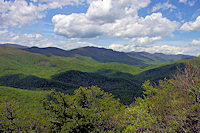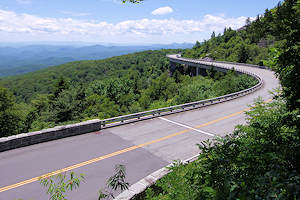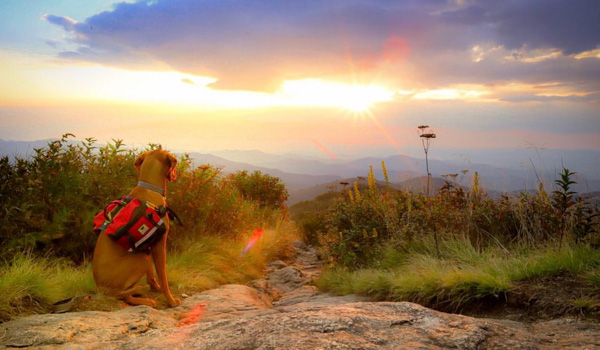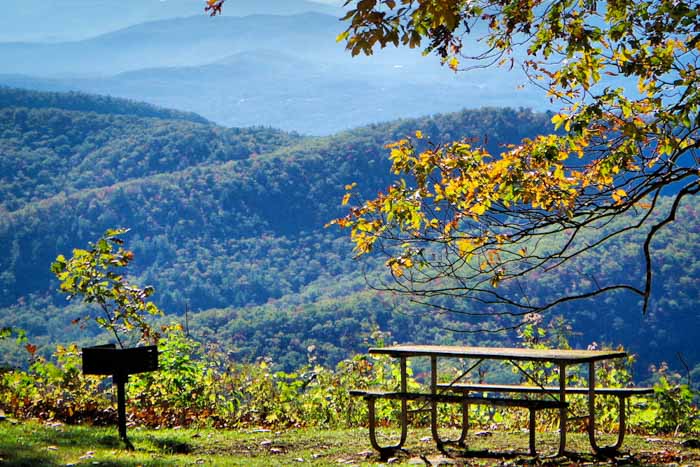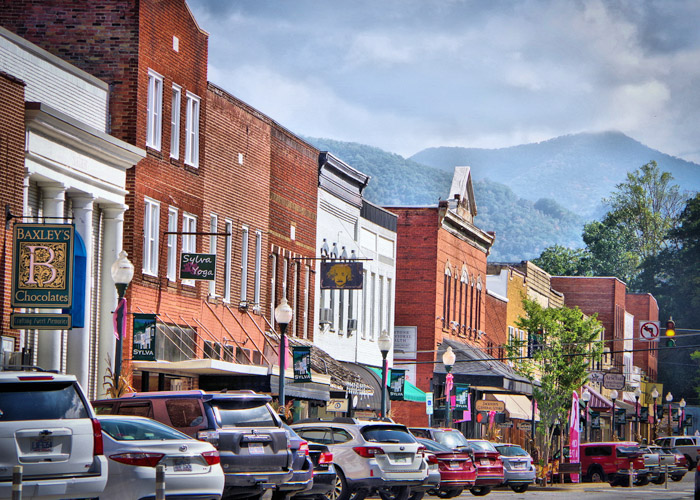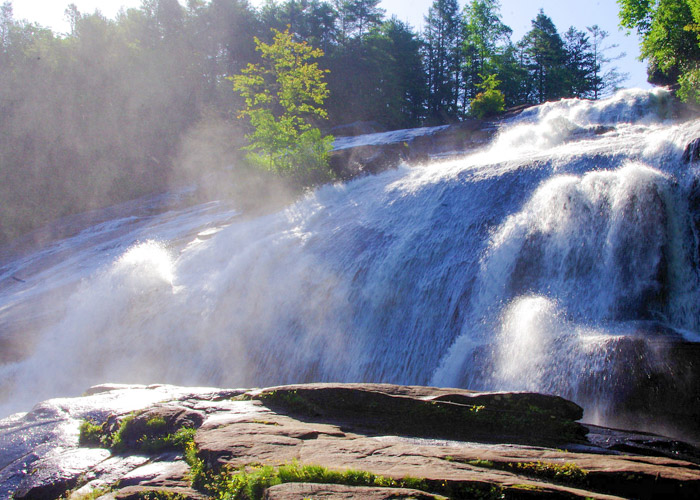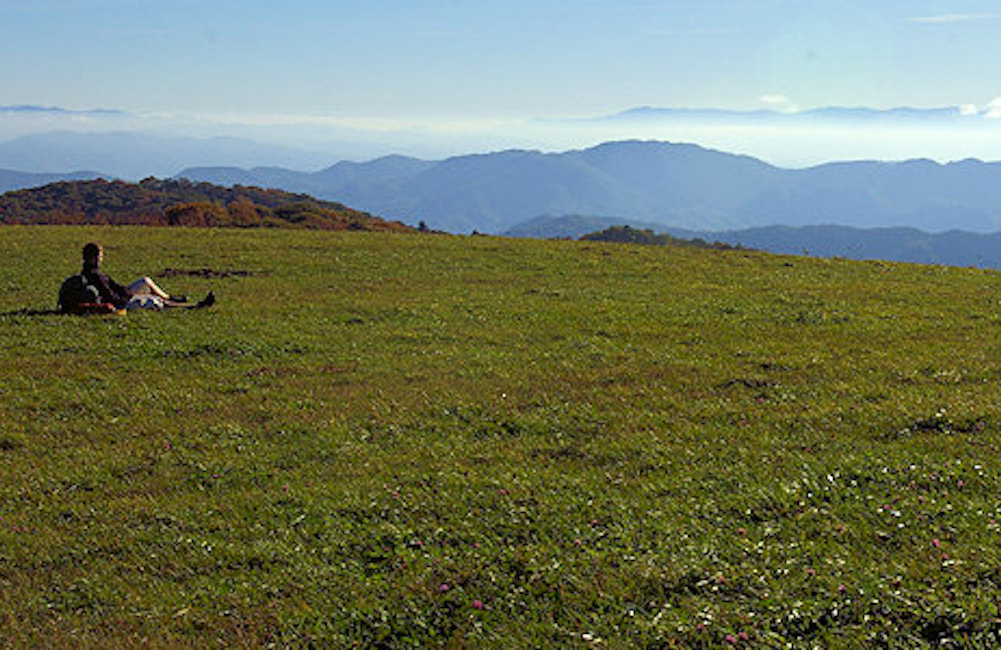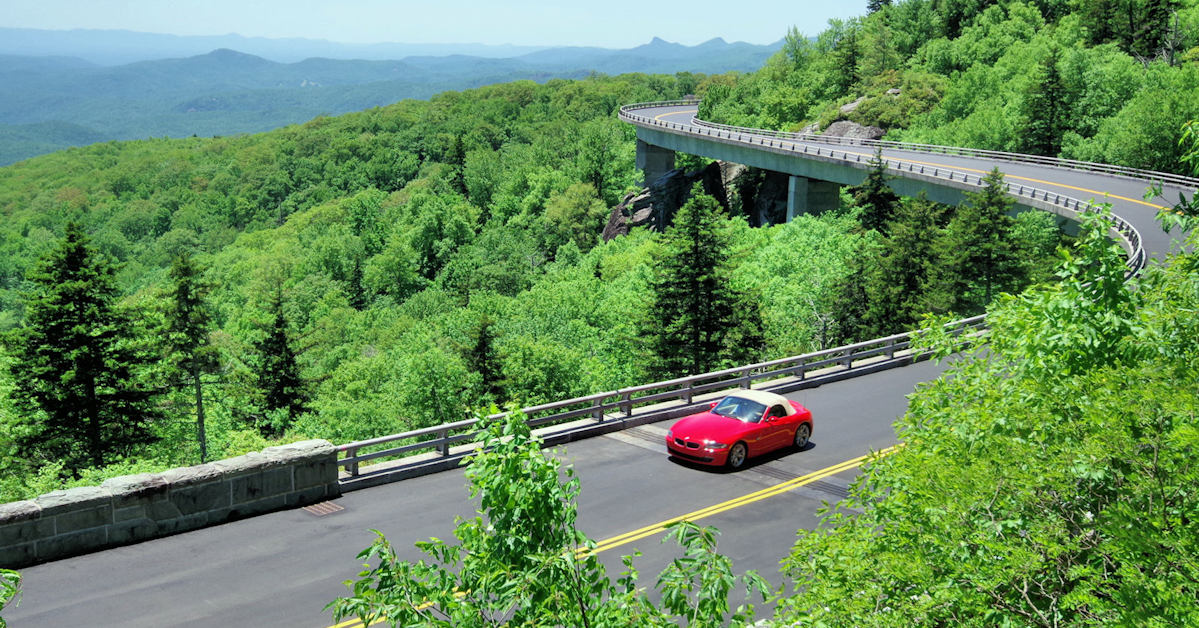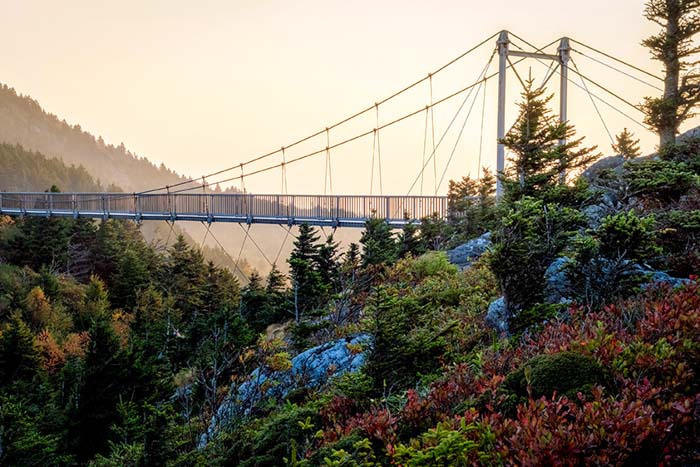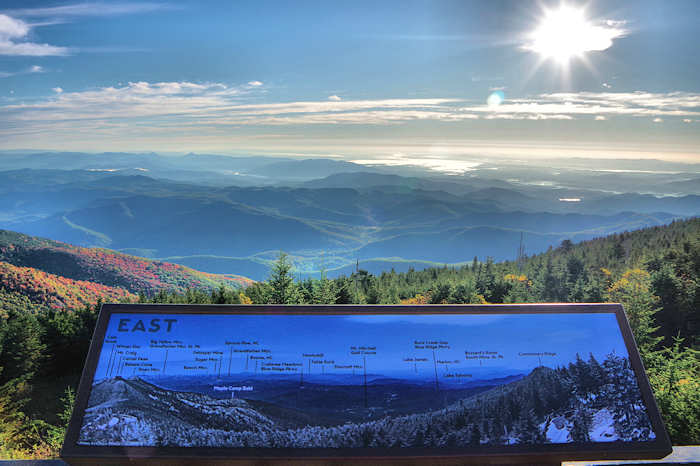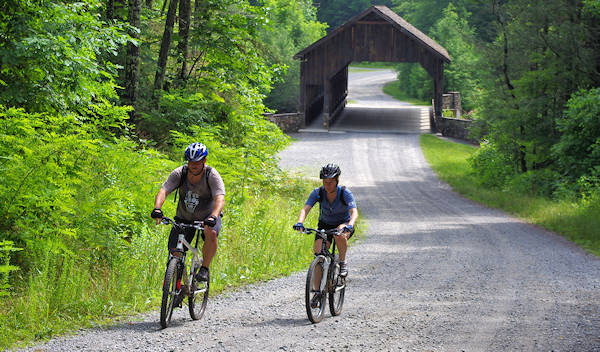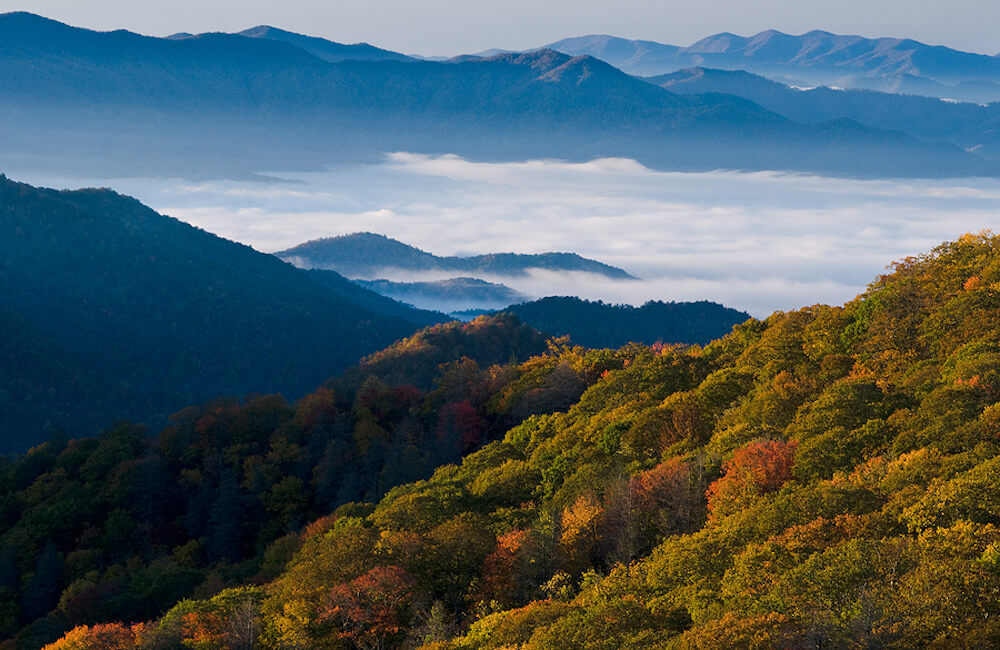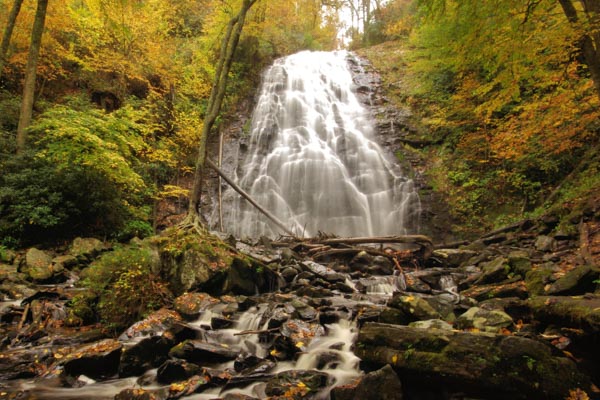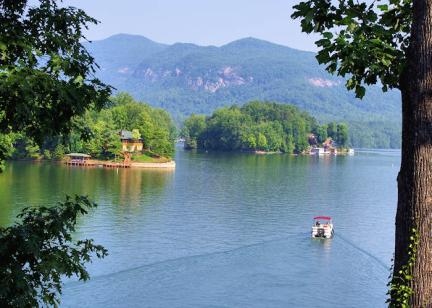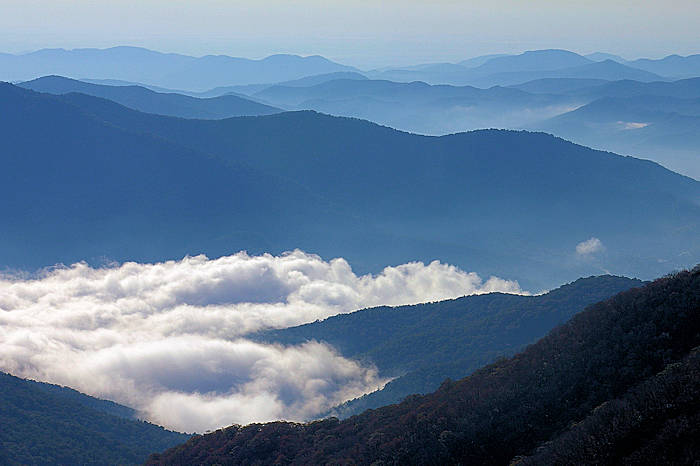
The beautiful Blue Ridge Mountains cover most of Western North Carolina, including Asheville. While they extend from Georgia to Pennsylvania, the highest peaks are found here. The highest point in the Blue Ridge is Mount Mitchell which reaches 6,684 feet in elevation. Located in Mount Mitchell State Park, just about 30 miles away from downtown Asheville, Mt. Mitchell is not just the highest peak in the Blue Ridge it is also the highest summit east of the Mississippi River.
Part of the Appalachian Mountains, the Blue Ridge is known for being shrouded in a lovely bluish haze, especially when seen from a distance. This phenomenon is actually caused by trees. Oaks and other trees that thrive in the Blue Ridge release isoprene, a common hydrocarbon, to protect their leaves from heat stress and those emissions create the famous blue tint you see in these mountains.
The Blue Ridge is also famous for being one of the most beautiful wilderness areas in the United States. Here you will find thousands of miles of hiking trails and many spectacular waterfalls. You don’t have to hike to enjoy the views though! The Blue Ridge Parkway, one of the most scenic drives in America, winds right through these mountains.
If you are planning a Blue Ridge getaway, Asheville is the perfect base camp for exploring these mountains any time of year. This travel guide will help you plan your trip. From outdoors activities like hiking, fly-fishing and tubing to scenic drives and fun mountain towns there is plenty to do and see and experience in the Blue Ridge Mountains.
Blue Ridge Mountains Things to Do
Pisgah National Forest Guide
Explore and play in 500,000+ acres surrounding Asheville with some of the most beautiful and rugged mountain scenery, creating some of the best recreational opportunities in eastern North America… read more
Explore and play in 500,000+ acres surrounding Asheville with some of the most beautiful and rugged mountain scenery, creating some of the best recreational opportunities in eastern North America. Pisgah National Forest covers much of the north and central western mountains of North Carolina - with rivers, waterfalls and hundreds of miles of trails.
Nantahala National Forest
The largest national forest in North Carolina (531,286 acres) covers much of the western tip of the state. Find a wealth of outdoor activities, including whitewater on the Nantahala River,… read more
The largest national forest in North Carolina (531,286 acres) covers much of the western tip of the state. Find a wealth of outdoor activities, including whitewater on the Nantahala River, waterfalls and plenty of scenic views.
Packages & Specials for Asheville & Mountains
Pick a package or special perfect for your vacation, with discounts and travel deals for hotels, resorts, bed and breakfasts, country inns and cabin rentals in the North Carolina mountains.
Pick a package or special perfect for your vacation, with discounts and travel deals for hotels, resorts, bed and breakfasts, country inns and cabin rentals in the North Carolina mountains.
Blue Ridge Parkway
One of the most scenics roads in America (and part of the National Park Service), the Blue Ridge Parkway offers unmatched, spectacular mountain scenery. Drive north or south on the Parkway from… read more
One of the most scenics roads in America (and part of the National Park Service), the Blue Ridge Parkway offers unmatched, spectacular mountain scenery. Drive north or south on the Parkway from Asheville and quickly ascend in elevation. It's all about the journey, so go slow, stop frequently and enjoy. To return to your starting point, you can often exit the Parkway onto a highway that…
Stand-Up Paddleboard Trips
Find the best places to stand-up paddleboard in and near Asheville on the pristine waters of the Blue Ridge Mountains. Rent SUPs, take lessons and even take a guided river trip. Fun way to see… read more
Find the best places to stand-up paddleboard in and near Asheville on the pristine waters of the Blue Ridge Mountains. Rent SUPs, take lessons and even take a guided river trip. Fun way to see fall color, too!
Pet-Friendly Guide
Traveling with your dog? See our Pet-Friendly Guide to Asheville and the North Carolina mountains that includes lodging, hiking, Biltmore, kennels, dog parks and more.
Traveling with your dog? See our Pet-Friendly Guide to Asheville and the North Carolina mountains that includes lodging, hiking, Biltmore, kennels, dog parks and more.
Top 20 Picnic Spots
Dine outdoors in nature! Plan a picnic at some amazing locations where you can enjoy sweet views.
Dine outdoors in nature! Plan a picnic at some amazing locations where you can enjoy sweet views.
Whitewater Rafting & Kayaking
We are lucky enough to have six rivers near Asheville that are good for rafting and kayaking. Find professional companies that provide rafting guides, so no experience is necessary. You can even… read more
We are lucky enough to have six rivers near Asheville that are good for rafting and kayaking. Find professional companies that provide rafting guides, so no experience is necessary. You can even learn how to kayak in the rapids or paddleboard on a lake.
Weekend Getaways: Discover Top 40 Coolest Mountain Small Towns Near Asheville
There are lots of options if you want to plan a few fun day trips while you are in Western North Carolina. Explore our favorite cool small towns in the NC mountains near Asheville, each with its… read more
There are lots of options if you want to plan a few fun day trips while you are in Western North Carolina. Explore our favorite cool small towns in the NC mountains near Asheville, each with its own personality, local shops and restaurants, friendly residents, and relaxed atmosphere.
Waterfalls Top 60
Of hundreds of waterfalls near Asheville, we picked the most spectacular falls that are easy to find. Some can be enjoyed with a short walk or even roadside. Others require a scenic hike. See full… read more
Of hundreds of waterfalls near Asheville, we picked the most spectacular falls that are easy to find. Some can be enjoyed with a short walk or even roadside. Others require a scenic hike. See full descriptions for each, with plenty of photos! Also see Waterfall Drives & Maps.
Appalachian Trail Day Hikes near Asheville
Take a "walk in the woods" in the most scenic sections of the 2,174-mile Appalachian Trail near Asheville, high in the North Carolina mountains. See our favorite six-day hikes for all fitness… read more
Take a "walk in the woods" in the most scenic sections of the 2,174-mile Appalachian Trail near Asheville, high in the North Carolina mountains. See our favorite six-day hikes for all fitness levels.
Fly Fishing
Enjoy plenty of fishing spots, whether novice or experienced. Full- and half-day guided trips, tying classes and classes geared toward women.
Enjoy plenty of fishing spots, whether novice or experienced. Full- and half-day guided trips, tying classes and classes geared toward women.
18 Scenic Drives
See gorgeous countryside, mountain views and charming communities on a windshield tour via national and state scenic byways near Asheville. Lots of opportunities for stops along the way.
See gorgeous countryside, mountain views and charming communities on a windshield tour via national and state scenic byways near Asheville. Lots of opportunities for stops along the way.
Grandfather Mountain
Don’t miss the views that can be seen from Grandfather Mountain, which at 5,946 ft’ is one of the highest peaks in the Blue Ridge Mountain range. Grandfather Mountain State Park encompasses 2,456-… read more
Don’t miss the views that can be seen from Grandfather Mountain, which at 5,946 ft’ is one of the highest peaks in the Blue Ridge Mountain range. Grandfather Mountain State Park encompasses 2,456-acres of wilderness to explore. If you are staying in Asheville, 70 miles from Asheville, just off the Blue Ridge Parkway.
Sliding Rock & Swimming Holes
Be a kid again and splash around in a cool mountain swimming hole. Ride down Sliding Rock, swim under a waterfall, sun on a mountain beach or pristine lake, or spend a lazy day tubing down a river… read more
Be a kid again and splash around in a cool mountain swimming hole. Ride down Sliding Rock, swim under a waterfall, sun on a mountain beach or pristine lake, or spend a lazy day tubing down a river.
Mount Mitchell
Drive to the top of the highest peak east of the Mississippi River, located along the Blue Ridge Parkway. This state park has an observation tower, plenty of hiking and a restaurant. Be prepared… read more
Drive to the top of the highest peak east of the Mississippi River, located along the Blue Ridge Parkway. This state park has an observation tower, plenty of hiking and a restaurant. Be prepared for much cooler temperatures at the top. Open year-round (except snowy days in the winter).
Mountain Biking
So many options for mountain bike riders of all skill levels. Plus, bike the Blue Ridge Parkway or a greenway.
So many options for mountain bike riders of all skill levels. Plus, bike the Blue Ridge Parkway or a greenway.
Great Smoky Mountains National Park Top 30 in NC
Explore the most visited national park in the country! See our top places and things to do in the Great Smoky Mountains on the North Carolina side near Asheville. Four entrances to the Park are… read more
Explore the most visited national park in the country! See our top places and things to do in the Great Smoky Mountains on the North Carolina side near Asheville. Four entrances to the Park are within 60 miles of downtown Asheville.
Top 8 Zip Line Canopy Tours
Fly above the trees and experience the mountains' natural beauty from a bird's perspective. See our favorite zip line canopy courses to enjoy in the Asheville area of the North Carolina Blue Ridge… read more
Fly above the trees and experience the mountains' natural beauty from a bird's perspective. See our favorite zip line canopy courses to enjoy in the Asheville area of the North Carolina Blue Ridge Mountains. No experience is needed. Canopy guides provide all instruction and assistance. It's fun for all fitness levels!
River Tubing
Find the best places to tube down a river on a hot summer day, including the French Broad River through Asheville, Deep Creek in the Smoky Mountains and Green River Gorge - with rentals and… read more
Find the best places to tube down a river on a hot summer day, including the French Broad River through Asheville, Deep Creek in the Smoky Mountains and Green River Gorge - with rentals and shuttle services.
Best 75 Mountain Hikes
There are thousands of miles of hiking trails near Asheville, many of which are in pristine national forests or parks. We picked our favorites and created extensive guides for each with photos and… read more
There are thousands of miles of hiking trails near Asheville, many of which are in pristine national forests or parks. We picked our favorites and created extensive guides for each with photos and details. Find hikes for all skill levels in the Blue Ridge and Smoky Mountains.
Beautiful Blue Ridge Every Season of the Year
Each season brings its own beauty to the Blue Ridge Mountains.
- Winter is typically mild in the valleys, but delivers plenty of snow in the high elevations where the ski resorts are found. The lack of tree leaves means that winter hikes can offer some of the best long range views of the year.
- Spring is a season of greening–new leaves appear first in the valleys then spread all the way up to the mountaintops. Wildflowers abound and flowering shrubs such as rhododendron, flame azalea, and mountain laurel provide splashes of color among the greenery.
- Summer brings plenty of sun and warm days. Common afternoon rain showers keep the leaves green and the waterfalls flowing.
- Fall is a favorite time of year for many as the foliage turns from green to vibrant red, yellow, and orange. Dogwood, sourwood, blackgum, tulip-poplar, hickory, maple, oak–each variety of tree found in the Blue Ridge produces its own unique color. See Romantic Asheville’s Fall Color Forecast to get tips on the best time to visit this part of the Blue Ridge in Autumn.
There is so much to do here year round that you may want to plan multiple trips to see the best of the Blue Ridge each season. Just remember that no matter what time of year you come here to go exploring, temperatures can vary greatly. Typically, the city of Asheville is about 15 degrees warmer than the highest peaks. Even in summer you’ll want to bring a warm sweater or jacket with you for a hike in the upper elevations.
A List of National Parks and Forests of the Blue Ridge Mountains
Planning a trip to see the full Blue Ridge Mountain range? You’ll be making quite a road trip! The Blue Ridge Province stretches from Georgia through Tennessee, South Carolina, North Carolina, Virginia, West Virginia, Maryland, all the way to Pennsylvania.
If you plan on visiting all National Parks and Forests along the way, you have a lot of ground to cover: Shenandoah National Park and Skyline Drive in Virginia; the Blue Ridge Parkway, Pisgah National Forest, and Nantahala National Forest in North Carolina; Great Smoky Mountain National Park in NC and Tennessee; Cherokee National Forest in Tennessee, Chattahoochee National Forest in North Georgia; and the Jefferson and George Washington National Forests in Virginia.
